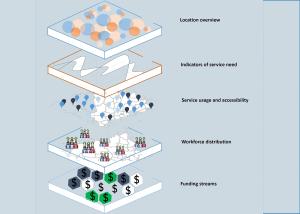By the Policy Projects and Taskforce Office, Department of the Prime Minister and Cabinet; NSW Cabinet Office
The Department of the Prime Minister and Cabinet (PM&C) and The Cabinet Office (TCO) NSW are delivering a joint project, with a funding injection from the APS Capability Reinvestment Fund 2024-25, to design, build and pilot a digital service mapping tool – the Digital Map of Human Services. The project aims to build public service capabilities to draw policy insights from integrated human services data, enabling evidence-based decisions to be made with an ecosystem view of human services delivery.
What is a service map?
Every Australian accesses human services in their lifetime. These interactions produce an abundance of data and information. Concurrently, the human services sector is facing increasingly complex and cross-cutting challenges as technology evolves and the population ages. The Australian Government is increasingly asking the APS to translate data into nuanced insights to inform targeted policies and effective service planning and improvement.
Service maps provide a locational view of the characteristics of services across different and complex service systems. Multi-layered service maps built on integrated, up-to-date datasets can help governments make better informed decisions, by presenting a local view of community needs and the types of services available from multiple governments, portfolios, and delivery organisations. They can provide a shared evidence base for the many actors in the human services ecosystem, and can foster collaborative partnerships to meet community needs. Service maps can help inform decisions to drive efficiency, productivity, and improved outcomes in human services.
Read more about service maps in the ‘Service Mapping 101 Guide’, which was developed by the joint PM&C and TCO project team.

The Digital Map of Human Services
Currently, service maps tend to be developed for a specific project. They are often produced from scratch, but are not maintained or shared beyond the life of the project. This can result in duplicated efforts across government to collect, combine, interpret, and present the same or similar data. The Digital Map of Human Services project aims to overcome this challenge by producing a human services data product and interactive tool that can meet common information needs across teams, portfolios, and governments.
This project will build on the considerable work to date by jurisdictions to improve linkage and safe sharing of government data, including work on the National Disability Data Asset and Australian National Data Integration Infrastructure. Our project will leverage valuable linked data assets and streamline safe access to the insights they can generate for policy and planning by producing aggregated linked data tables with a user-friendly interactive digital interface. The Digital Map will build in high-value data visualisations and insights interpretation features to make the tool and its underlying data accessible, meaningful, and usable for public servants with diverse levels of data literacy.
We have developed a proof-of-concept version of the Digital Map of Human Services to pilot with Commonwealth and State and Territory officials, initially focused on a service cohort of ‘at risk’ youth. In coming weeks, we will host a series of workshops for data and policy teams to understand how we can further develop the Digital Map for optimal functionality and to generate highest-value data insights. We are particularly interested in understanding the common underlying questions and data needs that cross policy areas. This approach ensures that future enhancements can be ‘bolted on’ as new information and datasets become available. Recognising that we are looking to build a platform to support enduring and dynamic service maps, we are also looking to understand non-government views around data sharing, usefulness, and accessibility.
Through the project, we intend to practically demonstrate how service maps can inform insights and support decision-making, and build a shared understanding across governments of the data and digital enablers required to support enduring and dynamic service maps—a core capability for effective government stewardship of human services and delivering long-term benefits to communities.
For further information, please reach out to Policy Projects and Taskforce Office and NSW Cabinet Office




